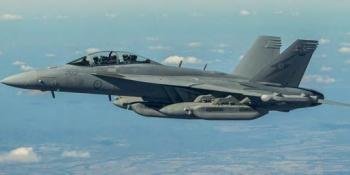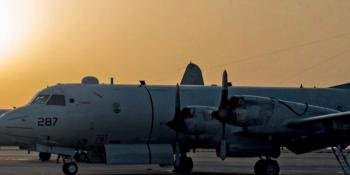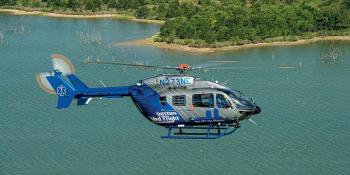ASIA

ADDITIONAL CAPABILITY for countries across Asia was in the news again as 2017 drew to a close, with details of upgrades and refurbishments, potential and new orders and future plans announced.
Lockheed Martin’s F-16 was prominent in the news, with Indonesia receiving its final batch of refurbished former US Air Force F-16s, and Taiwan detailing the timeline for its own F-16V upgrade programme. Both Japan and South Korea are mulling over the acquisition of the F-35B STOVL (short take-off and vertical landing) variant of the Lightning II to operate off its amphibious ships, and India’s Tejas programme inches along like a glacier.
Meanwhile, approval seems to have been granted in India for the acquisition of the last C-17A and Japan is signing a contract for its first KC-46A tanker.
A flurry of Fighting Falcons
The United States Air Force announced in early December it has completed work on the last six Lockheed Martin Block 25 F-16C and F-16D fighters it has refurbished for Indonesia. All aircraft have since been delivered to the Tentara Nasional Indonesia – Angkatan Udara (TNI-AU or Indonesian Air Force).
Indonesia has now received a total of 24 former US Air Force F-16Cs and F-16Ds refurbished by the Ogden Air Logistics Complex at Hill Air Force Base, Utah.
Meanwhile, Taiwanese media is reporting that the first four Republic of China Air Force Fighting Falcons to be upgraded to F-16V configuration by the country’s Aerospace Industrial Development Corporation will be delivered back to the Air Force in 2018.
China News Daily reports that the first aircraft will begin flight testing early in 2018, with deliveries to follow throughout the remainder of the year. Taiwan intends to upgrade 144 F-16A and F-16B fighters to F-16V configuration, which includes the replacement of the existing radar with Northrop Grumman’s APG-83 Scalable Agile Beam Radar, an active electronically scanned system.
Assuming funding is available, the Taiwanese Ministry of National Defence plans to upgrade all 144 aircraft by the end of 2023.
Asian F-35B Lightnings
Local media reports from Tokyo and Seoul in December suggest that both Japan and South Korea are considering the acquisition of F-35B STOVL Lightning IIs for operations from their respective amphibious ships. Both countries are already acquiring F-35A CTOL (conventional take-off and landing) Lightning II fighters.

The Japan Maritime Self Defense Force operates the 27,000-ton Izumo-class destroyer, and the Republic of Korea Navy operates the 18,800-ton Dokdo-class landing platform helicopter ship, but both vessels would require significant modification to accommodate the F-35B.
Japan’s Tokyo Shimbun newspaper says the F-35B is also being considered by the Japanese government for deployment further south in the Okinawa Prefecture to safeguard its territory against a backcloth of rising tensions in the region. However, Japan’s Minister of Defence, Itsunori Onadera, has publicly denied the government has any plans to modify its two Izumoclass ships.
Meanwhile in India
The Indian government has issued a request for proposal (RFP) to the country’s Hindustan Aeronautics Limited (HAL) for the potential supply of a further 83 Tejas Mk1A Light Combat Aircraft to bolster the dwindling Indian Air Force (IAF) fighter fleet. The IAF currently has 40 Tejas on order, comprising 20 Mk1s configured to initial operational capability (IOC) standard and 20 Mk1As configured to final operational capability standard.
The RFP was released on December 21 and negotiations are now underway to finalise a deal and sign a contract for the additional aircraft, with production planned to begin in the 2019–2020 timeframe.
According to Indian defence analysts, the IAF will retire 14 squadrons of MiG-21, MiG-27 and MiG-29 aircraft over the next decade, which will reduce the fighter force to 19 squadrons against the desired total of 33 if they are not replaced.
The Indian Ministry of Defence also revealed in December that Tejas production will be fast-tracked to address ongoing delays with the indigenous Light Combat Aircraft programme. By December 20, it revealed that just five of the 20 IOC standard Mk1 aircraft ordered in March 2006 had been delivered to the IAF. Delivery of these aircraft were originally planned to have been completed by December 2011.
The initial batch of 20 FOCstandard Mk1As was ordered in December 2010, for completion by the end of 2016, but none has thus far been completed. The Ministry of Defence said that in March 2017 the Indian government sanctioned the increase in Tejas production from eight aircraft per year to 16, and a second production line is being established at HAL’s facility in Bengaluru. It also said that it aims to achieve a reduction in the manufacturing cycle process through “improved supply chain management, learning and the augmentation of manpower”, as well as outsourcing several major components such as front, centre and rear fuselage assemblies, wings and various subassemblies. The Ministry of Defence added: “Further, in order to bolster the fighter squadron strength, [the] Government of India has also planned to manufacture fighter aircraft through [a] Strategic Partnership model.”
Grabbing the Globemaster
India finally seems likely to acquire the last unsold Boeing C-17A Globemaster III airlifter, after two years of procrastination by the government.
Last-minute approval for the acquisition was granted in December and a formal letter of offer and acceptance is expected shortly. If this does indeed eventuate, it will take the number of C-17s in IAF service to 11 aircraft, all serving with No.81 ‘Skylords’ Squadron, based at Hindon Air Base on the outskirts of Delhi.
The IAF had requested an additional three aircraft in 2015, but, due to the interminable local bureaucratic process, it missed the opportunity to secure three of Boeing’s white-tail aircraft and only a single aircraft remains unsold.
Also in December and on a more positive note, Boeing formally congratulated the IAF on achieving 12,000 flight hours with its C-17A fleet since the type first entered service in 2014.
Pegasus for Japan
Boeing announced on December 22 that it has received a $288 million FMS contract for the Japan Air Self Defense Force’s (JASDF) first KC-46A Pegasus tanker.
The KC-46A is based on the commercial Boeing 767-200 airframe (designated 767-2C) and the JASDF’s has four aircraft on order to supplement its existing fleet of KC-767J (767-2KFER) aircraft, which were delivered from 2008. The original four aircraft currently serve with the JASDF’s 404th Hikotai based at Komaki Air Base, Nagoya.
US Air Force Tanker Directorate Program Executive Officer Brigadier General Donna Shipton said: “We are excited to partner with Boeing as we assist Japan in advancing its aerial refuelling capabilities. This is an important step in strengthening the US-Japan alliance and will enhance our interoperability with both nations flying KC-46s.”






